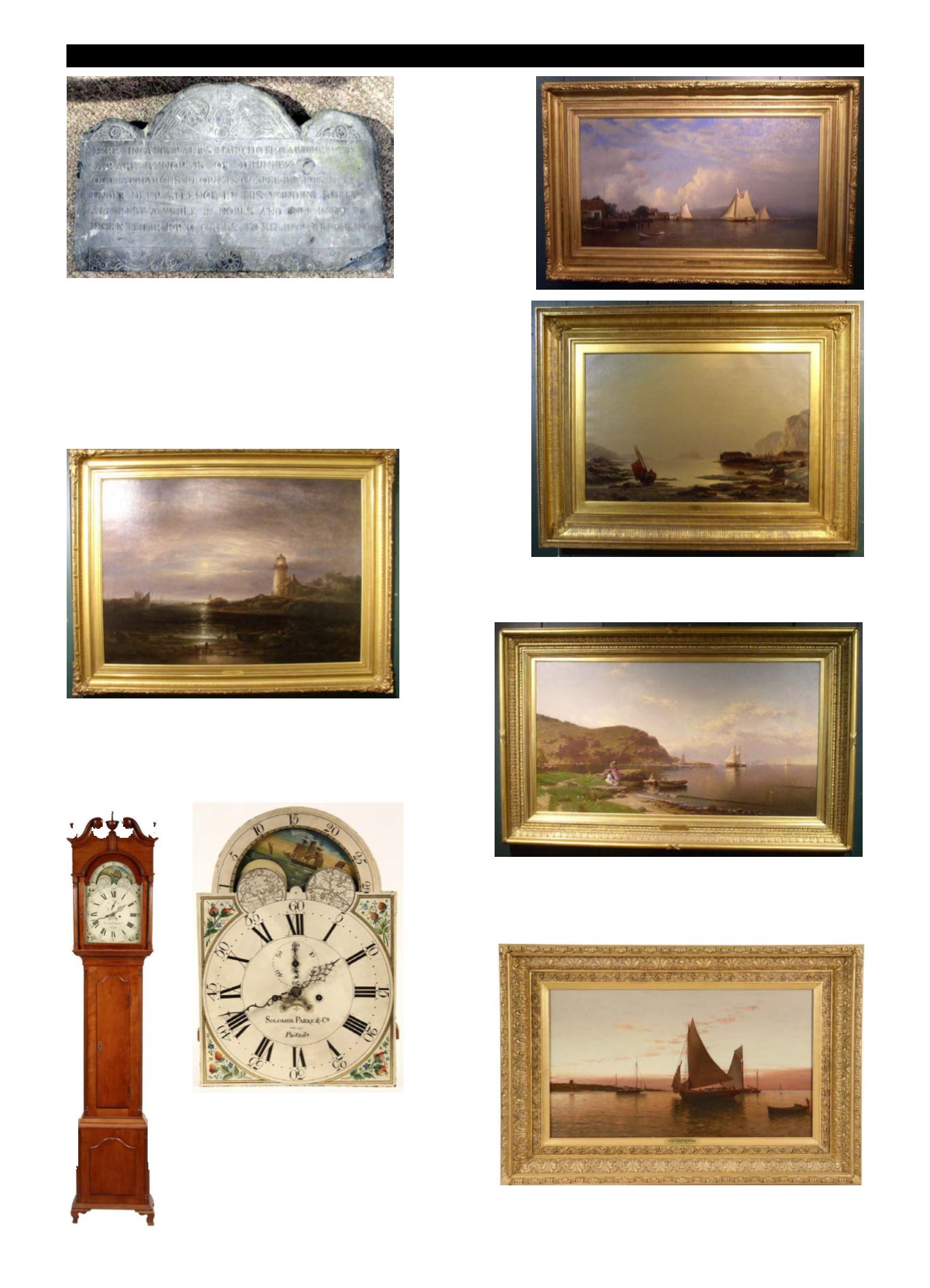

Maine Antique Digest, December 2016 5-B
-
AUCTION -
5-B
Thomaston Place was being cautious when it quietly removed lot four from
the sale. It was a fragment of an 18th-century slate tombstone supposedly
from a Friendship, Maine, farmhouse. It had a carved inscription reading
in part, “HERE INATYRANT’S HAND DOTH CAPTIVE LYE / ARARE
SYNOPSIS OF DIVINITY….” I found records of similar inscriptions
on tombstones from Maine and Massachusetts. There were too many
unresolved questions about its authenticity.
“We have got so many calls on this thing,” Kaja Veilleux reported.
“Some historical society said they owned it once. Then somebody called and
said it’s absolutely not period…. So right now we’ve got disputing things
between people that say it isn’t and people that say it is.” Lack of lichens
and staining, unworn script lines, and possible saw cuts all worked against
its authenticity. So down the rabbit hole it went, not to return.
On the Hudson Near Tappan
Zee
, 30" x 46", by Francis
Augustus Silva (1835-1886)
made $163,800.
William Bradford (1823-
1892) was raised in New
Bedford, Massachusetts,
then the heart of the
whaling industry. In 1861
he began a series of trips
to Labrador, Nova Scotia,
and Greenland where he
painted scenes often in spectacular, dramatic light. This 32" x 42" oil on canvas shows a misty sunrise
behind a desolate pier and a fishing boat in the foreground. It sold for $52,650
(est. $75,000/80,000).
Thomas Doughty (1793-1856) is credited with being one of the earliest
American painters to focus almost exclusively on landscapes. His depiction
of the Desert Rock Lighthouse of Maine, now known as the Mount Desert
Rock Light, was made into an engraving by William Radclyffe in 1839. The
lighthouse itself was established in 1830, but the current structure wasn’t
built until 1847. Said to be one of the earliest depictions of a Maine lighthouse,
the oil on canvas (44¾" x 58½" sight size) was one of the largest paintings in
the sale. It was estimated at $40,000/60,000 and hit the mark at $46,800.
This 37" x 58" oil on canvas by Alfred Thompson Bricher (1837-1908), signed lower
right and dated 1887, with the location given as “Near Cape Elizabeth, Portland,
Maine” via a paper label from the William Vareika Fine Arts Gallery, Newport,
Rhode Island, shows a trio of Victorian women enjoying a cool seaside respite on
a rocky and sandy beach with brilliant green shore grass in the foreground. It sold
under the $200,000/300,000 estimate for $175,500.
This 27½" x 41" oil by Alfred Thompson Bricher, titled on the frame
Twilight
Seascape
, signed lower right, and with a Godel & Co. Fine Art gallery label,
ended at $76,050 (est. $60,000/70,000). Thomaston Place photo.
Solomon Parke worked as a watch- and clockmaker as early
as 1782 in Bucks County, Pennsylvania, and moved in 1797
to Philadelphia, where he worked until 1822. This Federal
tall clock in a cherry case has a swan’s-neck pediment with
three wooden finials, fluted full columns on the bonnet, a
white-painted dial with floral-painted spandrels, a moon-
phase register, a minutes dial, and a calendar aperture.
Some sources claim that the “SOLOMON PARKE & CO.
/ PHILAD.” lettering represents his earlier Philadelphia
works. Others place it more toward the end of his career.
Either way, it went home for a respectable $5850.
Thomaston Place photos.











